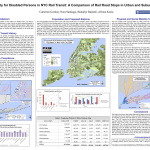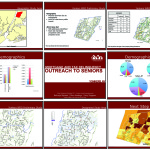ESRI Interntional User Conference
2013
 Nora Santiago M.S.U.A ; Bukurije Bajrami, Dr. Cameron Gordon, Afrona Kaziu, Accessibility for Disabled Persons in NYC Rail Transit: A Comparison of Rail Road Stops in Urban and Suburban Areas
Nora Santiago M.S.U.A ; Bukurije Bajrami, Dr. Cameron Gordon, Afrona Kaziu, Accessibility for Disabled Persons in NYC Rail Transit: A Comparison of Rail Road Stops in Urban and Suburban Areas
New York is a city of over 8 million people. 64% of New Yorkers live within ½ mile of a train station; over 25% of these residents are disabled. Within the five boroughs, there are 468 train stations, but of these only 67 are accessible by Americans with Disabilities Act (ADA) standards. The Metropolitan Transit Authority (MTA) has mandated the opening of 100 ADA compliant stations by 2020. This will bring the available number of ADA compliant stations to 21%, still leaving a large mobility and accessibility services gap for disabled residents. This transit gap will grow as the population ages. Transportation infrastructure investment must thus prioritize the needs of the growing disabled and elderly population. This study analyzes the existing and proposed updates to the NYC Subway system in comparison with other NY rail systems, including both urban and suburban lines.
 Nora Santiago M.S.U.A ; Bukurije Bajrami, Lucy Zappone, Mortgage and Tax Delinquency – Outreach to Seniors
Nora Santiago M.S.U.A ; Bukurije Bajrami, Lucy Zappone, Mortgage and Tax Delinquency – Outreach to Seniors
One in every six residents of Yonkers, NY, is over the age of 65, and many will lose their home as a result of delinquent property taxes. Due to the overwhelming mortgage crisis, tax foreclosures are often overlooked, as they disproportionately affect the elderly population; most of whom live on fixed-incomes. This case study describes our efforts to better understand, educate and engage the elderly community of Yonkers, while promoting free counseling services available to them using GIS and working in partnership with a community-based nonprofit agency. Specifically, using GIS (1)to locate and spatialize the problems to effectively describe and explain the issues to a wide variety of stakeholders (2)to design a pilot outreach program to connect with spatially dispersed elderly residents presently facing tax liens, as well as those likely to experience these problems in the near future, and (3)to gain community and political advocates for seniors facing tax foreclosure.
